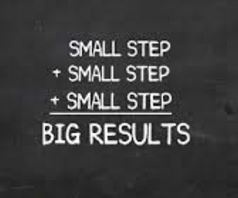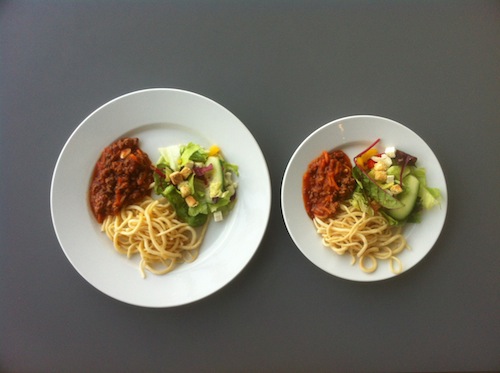The whole ethos behind ‘A Year Of Small Changes’ is to offer information and support to people looking to make small, meaningful changes in their day to day lives that, over time, will lead to bigger, more impactful changes as we become aware of the benefits of our new habits.

This week, we thought we would focus on how our environment affects our ability to change our behaviour.
There is no doubt that the environment we live and work in influences our behaviour but you may be surprised at how much impact your environment has on your habits.
You might think your habits such as what you eat, how much you exercise, whether you floss your teeth or not are purely a product of planning, motivation, ability and hard work. However, research suggests your surroundings can have a big impact on your ability to create and maintain good habits as well as break bad ones.
In 1936, a man named Kurt Lewin wrote a simple equation that changed the way we think about habits and human behavior.
The equation makes the following statement: Behavior is a function of the Person in their Environment.

Lewin’s belief is that it is not just your personal characteristics, but also your environment that drives your behavior.
We make hundreds of decisions every single day. Some of these we make with seemingly little conscious thought, for example which cup we use for our morning coffee, whether we salt our eggs at breakfast. We make many of these decisions so automatically that we probably don’t even think of them as decisions at all.

Others seem to involve a slightly more thorough decision making process such as what to have for dinner, whether to go to the gym after work, when to head to bed or what to buy from the supermarket.
Then you have the more obvious bigger decisions. Things like what holiday to book, how much you want to spend on a new car, and decisions you make at work, in my case things like weighing up the options to create a management plan for a patient.
All of these are influenced by the environmental cues that surround us.
These cues can trigger certain thoughts and desires which push us towards making certain choices.

For example, if I keep a bottle of water on my desk at work I’m more likely to choose to drink throughout the day rather than having to motivate myself to get up and walk through the building to the water fountain.
Or, if I carry a book or my kindle with me when running the kids to their various clubs I’m more likely to choose to read while I’m waiting (something that I love) as opposed to going onto my phone and getting caught up in work.
Similarly, if I go to work without having packed a lunch (I rarely have time to go to a shop to buy one) I usually end up in the coffee room ravenous, faced with a full biscuit tin and an always open box of chocolates. Chances are, that’s what I’m having for lunch whereas if the coffee table was groaning with the weight of fresh fruit and the cupboard stocked with tins of tuna I would likely make a different choice.
If one of my colleagues decides to head out for a ten minute walk at lunch time, I’m more likely to do the same. Especially if I’ve got a pair of trainers in my room.
Using the examples above, with the best of intentions, if I set out that morning planning on getting my 10 fruit and veg in and keeping my steps up if my work environment is not conducive to pushing my towards my goals then I’m far less likely to make the positive choices I set out to make that morning.
‘Changing yourself begins with changing your environment’
As humans, we are cursed with limited amounts of willpower and, as such we cannot rely on willpower alone to help us make the right decisions to improve our health and wellbeing.

Once willpower runs out and we are tired, our brains become overwhelmed.
From this point we go back to relying on our daily HABITS which we have practised over and over again and as such have become almost automatic actions rather than decisions eg locking the front door, brushing our teeth, picking up a biscuit from the tin next to the kettle.
Moving away from habits or creating new ones takes willpower, especially if you cannot see the benefit of the change right away eg changing your eating habits, exercising more.

At some point, for most people within the first few weeks, our willpower or mental energy runs out and we end up, once again, taking the path of least resistance and going back to old habits.
By changing your environment your can improve your chances of maintaining the change you want to make.
‘Design your surroundings to make good choices’
Making Small Changes to your environment makes it easier to achieve your goals without having to put too much thought into it.
Having a better option within easy reach makes it the default choice rather than a choice you have to use a lot of energy and willpower to make.
Create an environment that encourages healthy eating habits
A good example of this is the study carried out by Brian Wansink at Cornell University. The study found that people ate 22% less food simply by switching form a 12 inch dinner plate to a 10 inch dinner plate.

This would be my first tip if you feel you struggle with portion control or knowing when you are full and often end up over eating.
Other things you can try here are avoiding having foods that you either feel you have poor control around (often things like biscuits, cheese, chocolate, crisps) easily accessible. Instead, buy them in smaller amounts or choose to not have them in the cupboards at all.
The idea isn’t that you can’t eat these foods (or that you shouldn’t-no food should be off limits) BUT if you find yourself eating more than you need or, ultimately, enjoy on a regular basis then why not just avoid having them around in the first place? I guarantee that you are less likely to have that biscuit if you have to get up, get your shoes on and walk or drive to the shops to buy it.
If you want to eat more fruit and veg (again, one of the best things you can do for your health) then try having lots of it in easy reach. Carry them as snacks to work, keep carrots, cucumber or whatever you fancy cut up in the fridge so its ready to eat. Or, leave it lying out after dinner so that you see it first if you feel hungry later on.

Bulk cook your food at the weekend so you have lunches and dinners ready to go. Nothing like a trip to the supermarket when you are hungry and tired to scupper your good intentions!
A good environment for sleep
Izzy covered this brilliantly in her sleep blog which you can find on the website.
As a wee reminder good tips for healthy sleeping environment:
Don’t have your phone within reach of your bed-far less likely to play on it/answer texts etc. Same goes for any laptop/tablet andother sleep stealing devices.
Make your bedroom DARK, QUIET, COOL and CLUTTER FREE to make falling asleep seem like the only option when you are in there. Move that treadmill/guitar and all other clutter out of the room that should be a haven for sleep.

Dim the lights in whatever room you are in in the hour leading up to bedtime. Subconsciously your body will be choosing to get ready to sleep.
Becoming more active
If you want to fit more activity into your week then change your environment to make it as easy as possible to choose to be active.
Keep a spare gym bag or pair of trainers in the boot of your car or under your desk at work. You are far more likely to get out for a wee walk or get to the gym if you have the stuff you need with you.

Make yourself have to ‘OPT OUT’. Book into a gym class, yoga class or arrange to meet a friend. Once you have committed to something and it’s in the diary that decision is pretty much made already. You are much more likely to actually go that to OPT OUT.
Build that community
Building relationships doesn’t come easily for everyone. If you want to work on building your community then create an environment that supports your goals.
Why not block the social media apps on your phone to encourage to towards going out to connect with people?

Change your route to or from work to go past a new club or gym or any place that you want to check out or, like above, OPT IN and commit to going to a club, class our group so you have to OPT OUT if you want to change your mind which is an extra barrier to not following through.
Create an environment to help you de stress.
There are lots of things you can change in your environment both at home and at work to help you on your way to creating stress reducing habits.
Choose décor carefully. Opt for calming colour schemes, relaxing pictures or wall art, comfortable chairs and couches and perhaps add a few items that make you feel happy. I love my oil diffuser and find different blends help me feel more relaxed.
If you find playing your guitar, doing some yoga or reading relaxing then have your guitar out on a stand rather than in a cupboard, your yoga matt rolled up against the wall rather than tucked away somewhere and your book on the coffee table so you get a visual cue as you walk past.

This greatly increases the chance you will actually pick up one of these things and use them.
Once you have decided what new habits you want to make, sprinkle as many triggers for that new behaviour in your surroundings to increase the chance of reminding yourself of the new habit throughout the day.
I’m currently working on drinking more water, reading more and getting out for a walk.
I found that taking a water bottle to work didn’t work as I often left it in the car, or forgot to take it upstairs at work so now I have 3 (one for in the car, one for my room at work and one for upstairs at work) so that I am constantly being reminded to drink more.

I’ve got trainers sitting at the front door of the house, at work and in my car so I’m seeing them several times a day. I know if I do this for long enough it will turn into a habit and I’ll build it into my daily routine automatically.

Lastly, we are taking the TV remotes and putting them away in a cupboard for the last couple of hours before the kids bedtime. In their place we have put a box of books and magazines for us and the kids to pick up in the hope of switching some TV time to reading time. Seems to be working so far!


The take home message here is to Be the architect of your own environment!
This should massively improve your success rate when it comes to creating healthy habits!
Let us know how you get on.
Laura ??⚕️
©AYOSC 2019
3 replies to "Want to make changes? Start by changing your environment."
Love this one. Full of really good advice and tips.
I agree with the majority of the article but there were a couple of points I am unsure of. The thought that changing our environment produces changes in lifestyle choices is not always right. For instance I suffer bad health but I want to be fit. The idea of leaving trainers in a visible and accessable place as a trigger,seems like a no brainer. However I have found that due to health I can’t exercise or take that walk. Upon seeing the trainers I am left with a sense of failure or guilt. This does not help with my love of Mars bars. I just think sometimes these things can be helpful and sometimes the can be counter productive. I have however put a fruit bowl in my wee reading room.
I can absolutely see what you mean. When I was struggling to walk when my back condition was at it’s worst, seeing trainers lying out/other people walking/playing with their kids definitely made me feel worse. Instead, I did other things to try to both keep my mood up and not comfort eat/make less healthy options. I had some wee positive quotes pinned up around the house, kept healthy snacks lying out and easy to get hold of and made a list of things I could do to keep myself going physically. It’s really difficult to stay positive and motivated when you have health problems that limit you. Hope some of the suggestions work.